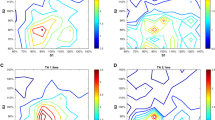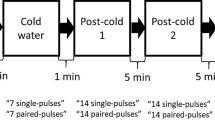Abstract
Transcranial magnetic stimulation (TMS) causes the corticospinal system to become refractory to subsequent stimuli for up to 200 ms. We examined the phenomenon of paired pulse inhibition with TMS under conditions of rest, ongoing voluntary activation (isometric force generation), and at variable delays following activation (postactivation) of the wrist extensors of seven normal subjects. Paired stimuli were delivered to the motor cortex with a circular coil at 1.1 times motor evoked potential (MEP) threshold, with various interstimulus intervals. Voluntary activation caused a marked decrease in the variability of the ratio of the amplitude of the MEP evoked by the test pulse to that of the MEP evoked by the conditioning pulse. Marked inhibition of the MEP evoked by the test pulse was still present. Postactivation, however, caused a dramatic reversal of the inhibitory effect of the conditioning pulse in all subjects at interstimulus intervals ranging from 40 to 120 ms. This effect lasted for up to 10 s following the cessation of activation. MEPs to transcranial electrical stimulation were also inhibited by conditioning TMS, but postactivation did not reverse this inhibition, indicating that the reversal of paired pulse inhibition is intracortical. We conjecture that paired pulse inhibition reflects activity of inhibitory interneurons or inhibitory connections between cortical output cells that are inactivated in the postactivation state.
Similar content being viewed by others
References
Amassian VE, Quirk GJ, Stewart M (1987) Magnetic coil versus electrical stimulation of monkey motor cortex (abstract). J Physiol(Lond) 394:119P
Asanuma H, Rosén I (1973) Spread of monoand polysynaptic connections within cat's motor cortex. Exp Brain Res 16:507–520
Brasil-Neto JP, Pascual-Leone A, Valls-Solé J, Cammarota A, Cohen LG, Hallett M (1993) Postexercise depression of motor evoked potentials: a measure of central nervous system fatigue. Exp Brain Res 93:181–184
Brasil-Neto JP, Cohen LG, Hallett M (1994) Central fatigue as revealed by postexercise depression of motor evoked potentials: is it caused by depletion of synaptic neurotransmitter stores? Muscle Nerve 17:713–719
Burke D, Hicks RG, Stephen JP (1990) Corticospinal volleys evoked by anodal and cathodal stimulation of the human motor cortex. J Physiol (Lond) 425:283–299
Calancie B, Nordin M, Wallin U, Hagbarth KE (1987) Motor-unit responses in human wrist flexor and extensor muscles to transcranial cortical stimuli. J Neurophysiol 58:1168–1185
Cowan JMA, Day BL, Marsden CD, Rothwell JC (1986) The effects of percutaneous motor cortex stimulation on H reflexes in muscles of the arm and leg in intact man. J Physiol (Lond) 377:333–347
Fuhr P, Agostino R. Hallett M (1991) Spinal motor neuron excitability during the silent period after cortical stimulation. Electroencephalogr Clin Neurophysiol 81:257–262
Inghilleri M, Berardelli A, Cruccu G, Priori A, Manfredi M (1990) Motor potentials evoked by paired cortical stimuli. Electroencephalogr Clin Neurophysiol 77:382–389
Inghilleri M, Berardelli A, Cruccu G, Manfredi M (1993) Silent period evoked by transcranial stimulation of the human cortex and cervicomedullary junction. J Physiol (Lond) 466:521–534
Krnjevic K, Randic M, Straughan DW (1966) An inhibitory process in the cerebral cortex. J Physiol (Lond) 184:16–48
Mills KR (1988) Excitatory and inhibitory effects on human spinal motoneurones from magnetic brain stimulation. Neurosci Lett 94:297–302
Pascual-Leone A, Valls-Solé J, Wassermann EM, Hallett M (1994) Responses to rapid-rate transcranial stimulation of the human motor cortex. Brain 117:847–858
Roick H, von Giesen H-J, Benecke R (1993) On the origin of the postexcitatory inhibition seen after transcranial magnetic brain stimulation in awake human subjects. Exp Brain Res 94:489–498
Rothwell J, Burke D, Hicks R, Stephen J, Woodforth I, Crawford M (1994) Transcranial electrical-stimulation of the motor cortex in man further evidence for the site of activation. J Physiol (Lond) 481:243–250
Samii A, Wassermann EM, Ikoma K, Mercuri B, O'Fallon A, Dale J, Strauss S, Hallett M (1994) Decreased post-exercise facilitation of motor evoked potentials in patients with chronic fatigue syndrome (abstract). Ann Neurol 36:288
Samii A, Ikoma K, Mercuri B, George MS, Hallett M, Wassermann EM (1995) Decreased post-exercise facilitation of motor evoked potentials in depressed patients (abstract). Neurology 45:A386
Samii A, Wassermann EM, Ikoma K, Mercuri B, Hallett M (in press) Characterization of post-exercise facilitation and depression of motor evoked potentials to transcranial magnetic stimulation. Neurology
Thomson AM, Deuchars J (1994) Temporal and spatial properties of local circuits in neocortex. Trends Neurosci 17:119–126
Valls-Solé J, Pascual-Leone A, Wassermann EM, Hallett M (1992) Human motor evoked responses to paired transcranial magnetc stimuli. Electroencephalogr Clin Neurophysiol 85:355–364
Wassermann EM, Pascual-Leone A, Toro C, Valls-Solé J, Cohen LG, Hallett M (1993) Topography of the excitatory and inhibitory effects of transcranial magnetic stimulation in a hand muscle. Electroencephalogr Clin Neurophysiol 89:424–433
Author information
Authors and Affiliations
Rights and permissions
About this article
Cite this article
Wassermann, E.M., Samii, A., Mercuri, B. et al. Responses to paired transcranial magnetic stimuli in resting, active, and recently activated muscles. Exp Brain Res 109, 158–163 (1996). https://doi.org/10.1007/BF00228638
Received:
Accepted:
Issue Date:
DOI: https://doi.org/10.1007/BF00228638




